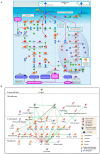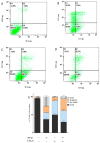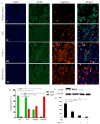Chemosensitization of HT29 and HT29-5FU Cell Lines by a Combination of a Multi-Tyrosine Kinase Inhibitor and 5FU Downregulates ABCC1 and Inhibits PIK3CA in Light of Their Importance in Saudi Colorectal Cancer
- PMID: 33440689
- PMCID: PMC7827067
- DOI: 10.3390/molecules26020334
Chemosensitization of HT29 and HT29-5FU Cell Lines by a Combination of a Multi-Tyrosine Kinase Inhibitor and 5FU Downregulates ABCC1 and Inhibits PIK3CA in Light of Their Importance in Saudi Colorectal Cancer
Abstract
Colorectal cancer (CRC) remains one of the main causes of death worldwide and in Saudi Arabia. The toxicity and the development of resistance against 5 fluorouracil 5FU pose increasing therapeutic difficulties, which necessitates the development of personalized drugs and drug combinations.
Objectives: First, to determine the most important kinases and kinase pathways, and the amount of ABC transporters and KRAS in samples taken from Saudi CRC patients. Second, to investigate the chemosensitizing effect of LY294002 and HAA2020 and their combinations with 5FU on HT29, HT29-5FU, HCT116, and HCT116-5FU CRC cells, their effect on the three ABC transporters, cell cycle, and apoptosis, in light of the important kinase pathways resulting from the first part of this study.
Methods: The PamChip® peptide micro-array profiling was used to determine the level of kinase and targets in the Saudi CRC samples. Next, RT-PCR, MTT cytotoxicity, Western blotting, perturbation of cell cycle, annexin V, and immunofluorescence assays were used to investigate the effect on CRC, MRC5, and HUVEC cells.
Results: The kinase activity profiling highlighted the importance of the PI3K/AKT, MAPK, and the growth factors pathways in the Saudi CRC samples. PIK3CA was the most overexpressed, and it was associated with increased level of mutated KRAS and the three ABC transporters, especially ABCC1 in the Saudi samples. Next, combining HAA2020 with 5FU exhibited the best synergistic and resistance-reversal effect in the four CRC cells, and the highest selectivity indices compared to MRC5 and HUVEC normal cells. Additionally, HAA2020 with 5FU exerted significant inhibition of ABCC1 in the four CRC cells, and inhibition of PIK3CA/AKT/MAPK7/ERK in HT29 and HT29-5FU cells. The combination also inhibited EGFR, increased the preG1/S cell cycle phases, apoptosis, and caspase 8 in HT29 cells, while it increased the G1 phase, p21/p27, and apoptosis in HT29-5FU cells.
Conclusion: We have combined the PamChip kinase profiling of Saudi CRC samples with in vitro drug combination studies in four CRC cells, highlighting the importance of targeting PIK3CA and ABCC1 for Saudi CRC patients, especially given that the overexpression of PIK3CA mutations was previously linked with the lack of activity for the anti-EGFRs as first line treatment for CRC patients. The combination of HAA2020 and 5FU has selectively sensitized the four CRC cells to 5FU and could be further studied.
Keywords: 5FU; ABCC1; PIK3CA; Saudi colorectal cancer; drug resistance; kinase pathway profiling.
Conflict of interest statement
The authors declare no conflict of interest.
Figures













Similar articles
-
HSP90 inhibition downregulates thymidylate synthase and sensitizes colorectal cancer cell lines to the effect of 5FU-based chemotherapy.Oncotarget. 2014 Oct 30;5(20):9980-91. doi: 10.18632/oncotarget.2484. Oncotarget. 2014. PMID: 25296971 Free PMC article.
-
Casein Kinase 2α Enhances 5-Fluorouracil Resistance in Colorectal Cancer Cells by Inhibiting Endoplasmic Reticulum Stress.Anticancer Res. 2020 Mar;40(3):1419-1426. doi: 10.21873/anticanres.14083. Anticancer Res. 2020. PMID: 32132038
-
LY294002 may overcome 5-FU resistance via down-regulation of activated p-AKT in Epstein-Barr virus-positive gastric cancer cells.BMC Cancer. 2010 Aug 13;10:425. doi: 10.1186/1471-2407-10-425. BMC Cancer. 2010. PMID: 20704765 Free PMC article.
-
Potential genetic biomarker of Saudi Arabian patients with colorectal cancer.Eur Rev Med Pharmacol Sci. 2022 May;26(9):3109-3126. doi: 10.26355/eurrev_202205_28728. Eur Rev Med Pharmacol Sci. 2022. PMID: 35587061 Review.
-
Antiproliferative and palliative activity of flavonoids in colorectal cancer.Biomed Pharmacother. 2021 Nov;143:112241. doi: 10.1016/j.biopha.2021.112241. Epub 2021 Sep 30. Biomed Pharmacother. 2021. PMID: 34649363 Review.
Cited by
-
In-vitro Cytotoxicity Investigations for Phytoconstituents of Saudi Medicinal Plants With Putative Ocular Effects.Integr Cancer Ther. 2024 Jan-Dec;23:15347354241256649. doi: 10.1177/15347354241256649. Integr Cancer Ther. 2024. PMID: 38819027 Free PMC article.
-
Identification of chemosensitizing agents of colorectal cancer in Rauvolfia vomitoria using an NMR-based chemometric approach.Front Chem. 2023 Jan 6;10:1069591. doi: 10.3389/fchem.2022.1069591. eCollection 2022. Front Chem. 2023. PMID: 36688051 Free PMC article.
-
Mechanism of Dahuang Mudan Decotion in the treatment of colorectal cancer based on network pharmacology and experimental validation.Heliyon. 2024 May 29;10(11):e32136. doi: 10.1016/j.heliyon.2024.e32136. eCollection 2024 Jun 15. Heliyon. 2024. PMID: 38882337 Free PMC article.
-
Antitumor Effects of a New Retinoate of the Fungal Cytotoxin Illudin M in Brain Tumor Models.Int J Mol Sci. 2022 Aug 13;23(16):9056. doi: 10.3390/ijms23169056. Int J Mol Sci. 2022. PMID: 36012321 Free PMC article.
-
Evaluation of the effects of a dasatinib-containing, self-emulsifying, drug delivery system on HT29 and SW420 human colorectal carcinoma cells, and MCF7 human breast adenocarcinoma cells.J Taibah Univ Med Sci. 2024 Jul 22;19(4):806-815. doi: 10.1016/j.jtumed.2024.07.002. eCollection 2024 Aug. J Taibah Univ Med Sci. 2024. PMID: 39170071 Free PMC article.
References
-
- Zeyad Saeed Al-Shahrani A.I.A.-R., Amal Nasser Al-Madouj M.S.H. Cancer Incidence Report Saudi Arabia. Saudi Health Council; Riyadh, Saudi Arabia: 2017. [(accessed on 8 January 2021)]. Available online: https://nhic.gov.sa/eServices/Documents/2014.pdf.
MeSH terms
Substances
Grants and funding
LinkOut - more resources
Full Text Sources
Other Literature Sources
Medical
Research Materials
Miscellaneous

